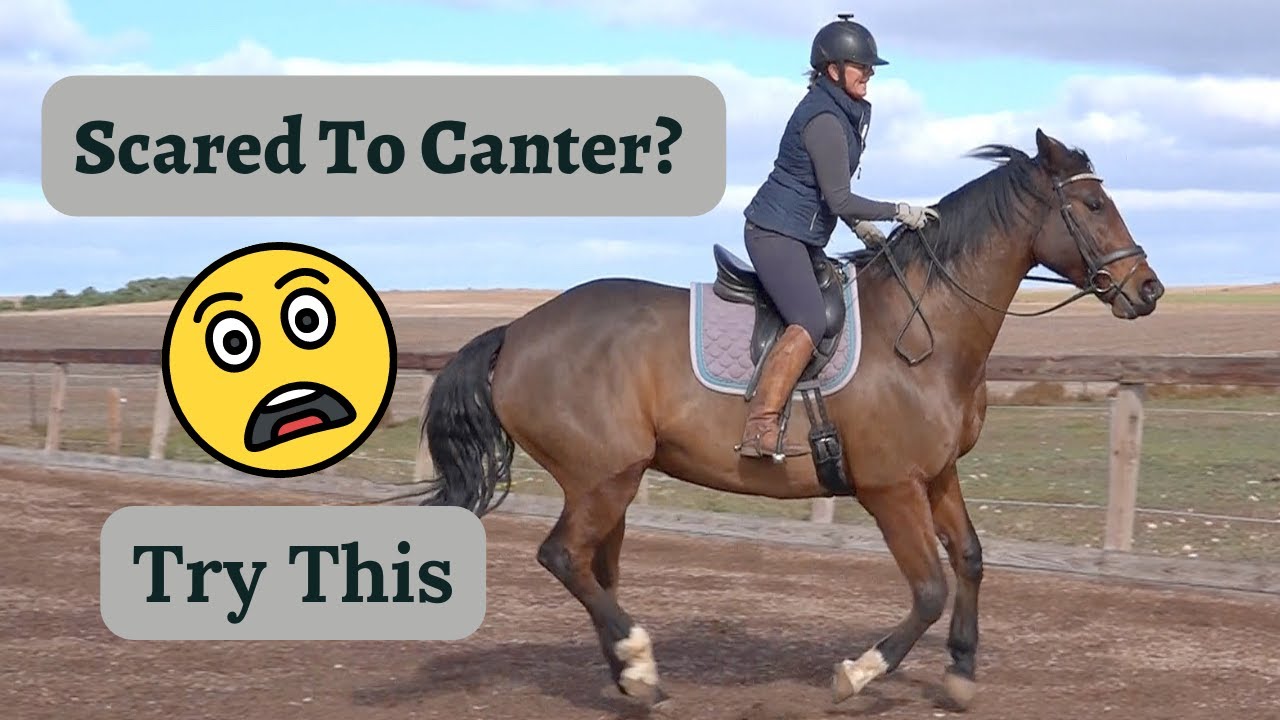Do you ever feel a little anxious when it comes to cantering on a horse? Maybe you’ve had a bad experience in the past or you’re just not quite sure how to feel comfortable at a faster pace. Well, fear not! In this article, we’re going to dive into the topic of how to overcome the fear of cantering in horseback riding.
Cantering can be an exhilarating and freeing experience, but it can also be a bit intimidating if you’re not used to it. We’ll discuss practical tips and techniques that will help you build confidence and overcome any anxiety or fear associated with cantering. Whether you’re a beginner or have been riding for years, there’s always something new to learn and ways to become more comfortable in the saddle. So, grab your helmet and let’s get started on this exciting journey! In the full article, we’ll explore in detail how to overcome your fear of cantering and provide you with helpful advice for building your confidence in the saddle. You’ll learn about the importance of proper instruction, gradual progression, visualization techniques, and much more. So, stay tuned and get ready to canter with confidence!
How to Overcome Fear of Cantering in Horseback Riding
Do you find yourself feeling anxious and fearful when it comes to cantering on a horse? If so, you’re not alone. Many riders experience fear when it comes to cantering, as it can be a fast and exhilarating gait that requires a certain level of skill and confidence. However, with the right techniques and support, you can overcome your fear and learn to enjoy the thrill of cantering in horseback riding.
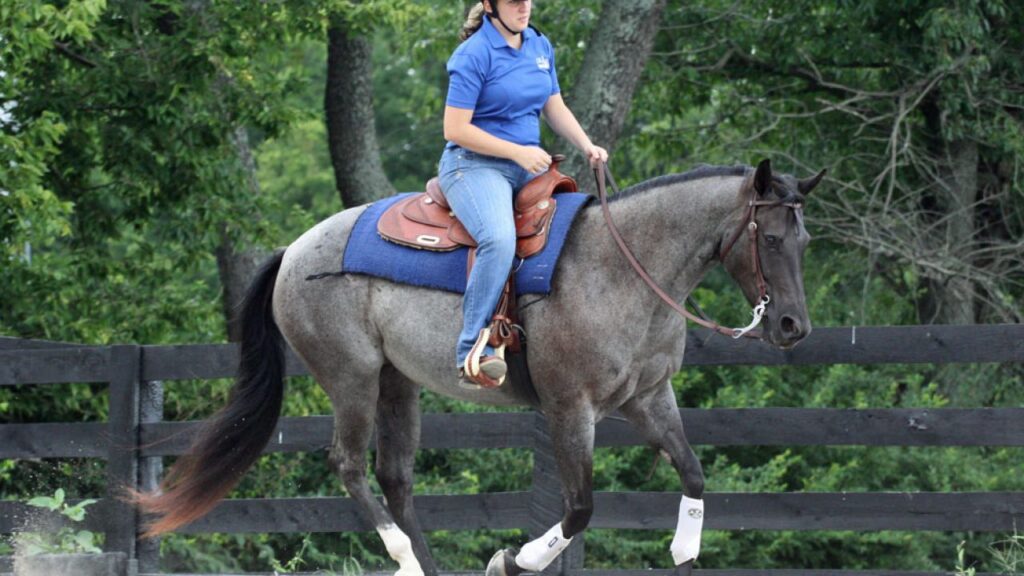
Understanding the Fear of Cantering in Horseback Riding
What is cantering in horseback riding?
Cantering is a three-beat gait that falls between the slower trot and the faster gallop. It is a controlled and rhythmic movement, where the horse’s legs move together on one side and then alternate on the other side. Cantering is often referred to as the horse’s “working gait” and is commonly used during competitions, trail rides, and general riding.
Why do some riders fear cantering?
There are several reasons why riders may fear cantering. It could be due to past negative experiences, a lack of confidence in their own abilities, a fear of losing control or falling off the horse, or simply a lack of knowledge about cantering techniques. Understanding the root causes of the fear can help riders address and overcome it.
The psychological aspects of fear in horseback riding
Fear is a natural human response to perceived threats or dangers. In the context of horseback riding, fear can be both beneficial and detrimental. It can help riders stay alert and cautious, ensuring their safety, but it can also hinder their performance and enjoyment. Understanding the psychological aspects of fear can help riders manage and overcome it.
Impact of fear on horseback riding performance
When fear takes hold, it can significantly impact a rider’s performance. Fear can lead to tension in the body, which can affect balance and communication with the horse. It can also hinder decision-making and create a negative mental state, making it difficult to focus and perform at one’s best. Overcoming fear is crucial for riders to excel and fully enjoy their horseback riding experience.
Identifying the Root Causes of the Fear
To overcome the fear of cantering, it is essential to identify its root causes. By understanding what triggers the fear, riders can take specific steps to address and overcome it.
Past negative experiences with cantering
Negative experiences, such as falls or accidents while cantering, can lead to fear and anxiety. It is essential to acknowledge and process these experiences, seeking support from instructors, trainers, or even therapists if necessary. By understanding that past experiences do not necessarily dictate future outcomes, riders can build the confidence needed to overcome their fear.
Lack of confidence in the rider’s ability
A lack of confidence in one’s own riding abilities can contribute to fear. Building confidence is a crucial part of overcoming the fear of cantering. By focusing on developing and honing riding skills through regular practice and instruction, riders can gradually build confidence in their ability to canter.
Fear of losing control or falling off the horse
The fear of losing control or falling off the horse is a common concern for riders. It is essential to recognize that horses are incredibly intuitive and capable animals. By working on building a strong bond with the horse, riders can develop trust and confidence, reducing the fear of losing control and enhancing their cantering experience.
Inadequate knowledge about cantering techniques
Lack of knowledge about proper cantering techniques can contribute to fear. It is crucial for riders to educate themselves about the mechanics of cantering, including body positioning, cues, and timing. Working with a qualified instructor or trainer can provide riders with the necessary guidance and expertise to develop proper cantering techniques and alleviate fear.

Building Trust and Confidence
Building trust and confidence is an essential step in overcoming the fear of cantering. By establishing a strong bond with the horse and gradually increasing the rider’s comfort level, riders can develop the trust and confidence needed to canter confidently.
Establishing a strong bond with the horse
Building a strong bond and connection with the horse is crucial for fostering trust and confidence. Spending time grooming, hand-walking, and engaging in groundwork exercises with the horse can help create a sense of trust and mutual understanding. The more time and effort riders invest in building a relationship with their horse, the stronger the bond will be.
Building a foundation of trust through ground exercises
Ground exercises can be valuable in building trust and confidence in both the rider and the horse. These exercises can include leading, lunging, and various desensitization exercises. By practicing these exercises regularly, riders can develop a deeper understanding of the horse’s behavior and body language, leading to increased trust and confidence.
Gradually increasing the rider’s comfort level
It is important to progress gradually and at a pace that is comfortable for the rider. Starting with small, controlled cantering exercises in a safe environment can help gradually increase the rider’s comfort level. Meticulous attention to building confidence through incremental progress will ensure a positive and enjoyable cantering experience.
Working with a qualified instructor or trainer
Working with a qualified instructor or trainer is invaluable in overcoming the fear of cantering. A knowledgeable professional can provide guidance, support, and expertise, ensuring that riders develop the necessary skills and techniques to canter safely and confidently. Their experience and expertise can help address specific fears and provide personalized guidance for each rider’s journey.
Developing Proper Riding Techniques
Mastering proper riding techniques is essential for both the rider’s confidence and the horse’s comfort. By focusing on mastering the basics, understanding body positioning during cantering, and learning the horse’s movements and cues, riders can canter more effectively and with greater confidence.
Mastering the basic riding skills
Before cantering, it is crucial to have a solid foundation in basic riding skills. This includes mastering the walk and trot, achieving balance and coordination, and understanding the use of rein aids and leg cues. By mastering the basics, riders can develop a strong foundation from which to build their cantering skills.
Learning proper body positioning during cantering
Proper body positioning is key to a successful canter. Riders should maintain a balanced and centered position, with a slight forward inclination. Keeping the heels down and maintaining a soft and supple seat can help riders maintain their balance and communicate effectively with the horse during the canter.
Understanding the horse’s movements and cues
Understanding the horse’s movements and cues is crucial for effective communication during cantering. Learning to feel the horse’s rhythm and tempo can help riders synchronize their own movements and maintain balance. Recognizing and responding to the horse’s cues, such as shifts in body weight or changes in leg pressure, can lead to a smoother and more controlled canter.
Practicing rhythmic breathing and relaxation techniques
Rhythmic breathing and relaxation techniques can help riders manage fear and anxiety during cantering. By focusing on steady and controlled breathing, riders can regulate their heart rate and promote a sense of calm. Incorporating relaxation techniques, such as visualization and positive affirmations, can further enhance the rider’s mental and emotional state, enabling them to canter with greater ease.
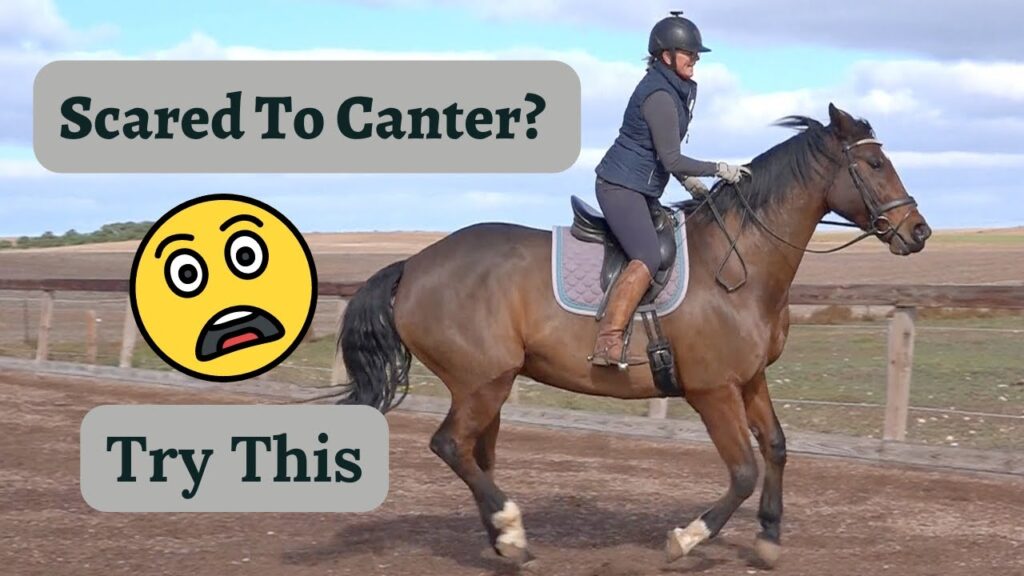
Working on Fear Management Strategies
To overcome the fear of cantering, it is essential to develop effective fear management strategies. These strategies can help riders recognize and challenge negative thoughts, utilize relaxation techniques, and gradually expose themselves to cantering in a safe and controlled manner.
Recognizing and challenging negative thoughts
Fear often manifests in the form of negative thoughts and beliefs. It is important for riders to recognize and challenge these thoughts, replacing them with positive and empowering statements. By reframing negative thoughts and focusing on accomplishments and capabilities, riders can shift their mindset and reduce fear.
Using visualization and positive affirmations
Visualization and positive affirmations can be powerful tools in managing fear. By visualizing successful cantering experiences and reciting positive affirmations, riders can create a mental image of success and reinforce positive beliefs. This technique can help shift the focus from fear to confidence, preparing riders mentally for a successful canter.
Utilizing relaxation techniques before and during cantering
Relaxation techniques, such as deep breathing and progressive muscle relaxation, can be beneficial in managing fear before and during cantering. By consciously relaxing the body and mind, riders can reduce tension and anxiety, promoting a sense of calm and control. Practicing these techniques regularly can help riders develop a relaxation response that can be accessed during cantering.
Gradual exposure and desensitization methods
Gradual exposure and desensitization are effective methods for overcoming fear. Starting with small, controlled cantering exercises and gradually increasing the duration and speed of cantering can help riders acclimate to the sensation and build confidence. Introducing different riding patterns and arenas, as well as practicing cantering on various terrains, can further desensitize riders and expand their comfort zone.
Addressing Safety Concerns
Safety is paramount in overcoming the fear of cantering. By addressing safety concerns and ensuring proper equipment, riders can enhance their confidence and minimize potential risks.
Choosing the right horse for cantering practice
Selecting a suitable horse for cantering practice is crucial for both safety and success. Horses with a calm temperament, well-trained gait transitions, and a willingness to cooperate can instill confidence in riders. Working with instructors or trainers to find the right horse can help ensure a positive cantering experience.
Ensuring proper equipment and protective gear
Using appropriate and well-fitted equipment is essential for safety during cantering. This includes a properly fitted helmet, comfortable riding boots, and a secure saddle and bridle. Ensuring that all equipment is in good condition and regularly maintained can minimize the risk of accidents and bolster the rider’s confidence.
Maintaining a safe riding environment
Creating and maintaining a safe riding environment is crucial for both riders and horses. Regular inspection of the riding arena or trail, identifying potential hazards, and implementing necessary safety measures can reduce the risk of accidents or injuries. Riders should also be aware of weather conditions and adjust their riding plans accordingly.
Knowing emergency procedures and protocols
Being knowledgeable about emergency procedures and protocols can provide riders with a sense of security. Knowing how to halt, steer, and control the horse in case of an emergency can be crucial in averting potential risks. Riders should also be familiar with basic first aid techniques and know how to seek assistance if needed.
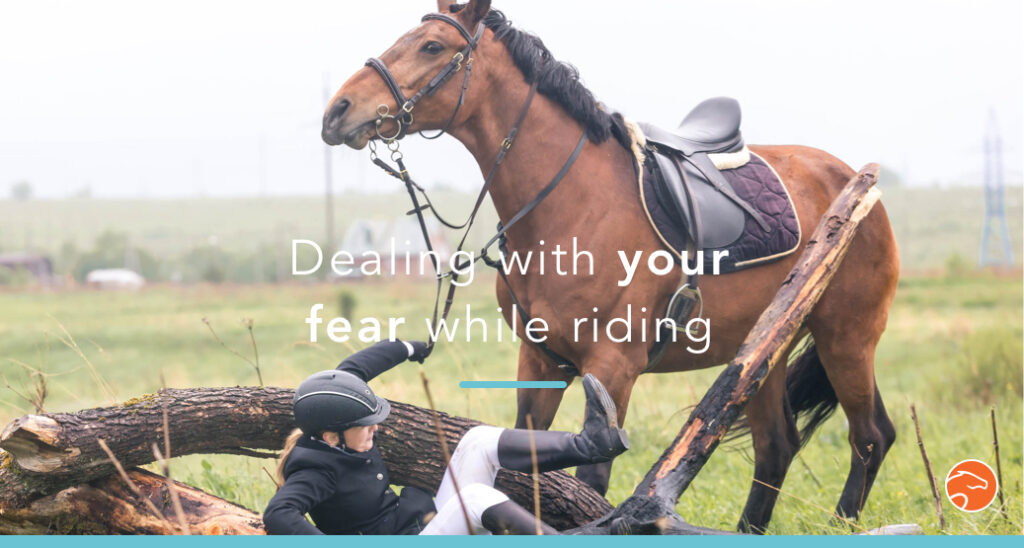
Seeking Professional Coaching and Support
In overcoming the fear of cantering, seeking professional coaching and support can make a significant difference. Working with qualified horseback riding instructors or trainers, joining group lessons or clinics, participating in support groups or forums, and considering therapy or counseling can provide valuable guidance, encouragement, and expertise throughout the journey of overcoming fear.
Working with a qualified horseback riding instructor
A qualified horseback riding instructor can be a valuable source of support and guidance in overcoming fear. An experienced instructor can assess the rider’s current skill level, tailor lessons to address specific fears, and provide constructive feedback and encouragement. Their knowledge and expertise can help riders develop confidence and competence in cantering.
Joining group lessons or clinics
Joining group lessons or clinics can offer additional opportunities for learning and support. Group settings provide riders with the chance to observe and learn from others, exchange experiences, and be part of a supportive community. The shared camaraderie and encouragement within a group can be highly motivating and uplifting.
Participating in support groups or forums
Support groups or online forums specifically dedicated to fear management in horseback riding can provide a sense of community and understanding. Engaging with others who have similar fears and challenges can offer validation, empathy, and practical tips for overcoming fear. Sharing experiences, progress, and setbacks with like-minded individuals can be both uplifting and inspiring.
Considering therapy or counseling for fear management
In some cases, fear of cantering may be deeply rooted and require professional support beyond horseback riding instruction. Therapy or counseling can provide a safe and confidential space for riders to explore and address underlying fears, anxieties, or trauma. A qualified mental health professional can offer personalized guidance and tools for managing fear and building resilience.
Gradual Exposure and Progressive Challenges
Gradual exposure and progressive challenges are key components of overcoming the fear of cantering. By starting small and gradually increasing the difficulty and complexity of cantering exercises, riders can build competence and confidence over time.
Starting with small, controlled cantering exercises
Begin by starting with small, controlled cantering exercises in a safe environment, such as an enclosed arena. Focus on maintaining a steady and rhythmic canter, practicing transitions from walk or trot to canter, and gradually increase the duration of cantering. Starting with short bursts of cantering and gradually building up can help riders acclimate to the gait and build confidence.
Gradually increasing the duration and speed of cantering
As riders become more comfortable with cantering, gradually increase the duration and speed of the canter. This can be done gradually over time, ensuring that the rider feels safe and in control throughout the process. Regular practice and repetition will help riders build the necessary strength, coordination, and confidence to sustain a canter for longer periods.
Introducing different riding patterns and arenas
To further challenge and desensitize riders, introduce different riding patterns and arenas. Riding in circles, figure eights, or serpentine patterns can help riders develop better control and balance while cantering. Changing the environment by riding on different terrains and exploring new trails can also provide valuable exposure to different situations and boost confidence.
Practicing cantering on various terrains
To enhance versatility and adaptability, practice cantering on various terrains. Riding on different surfaces, such as grass, sand, or gravel, can help riders become comfortable and confident in different footing conditions. Exposing riders to different terrains and challenging environments will increase their adaptability and further reduce fear.
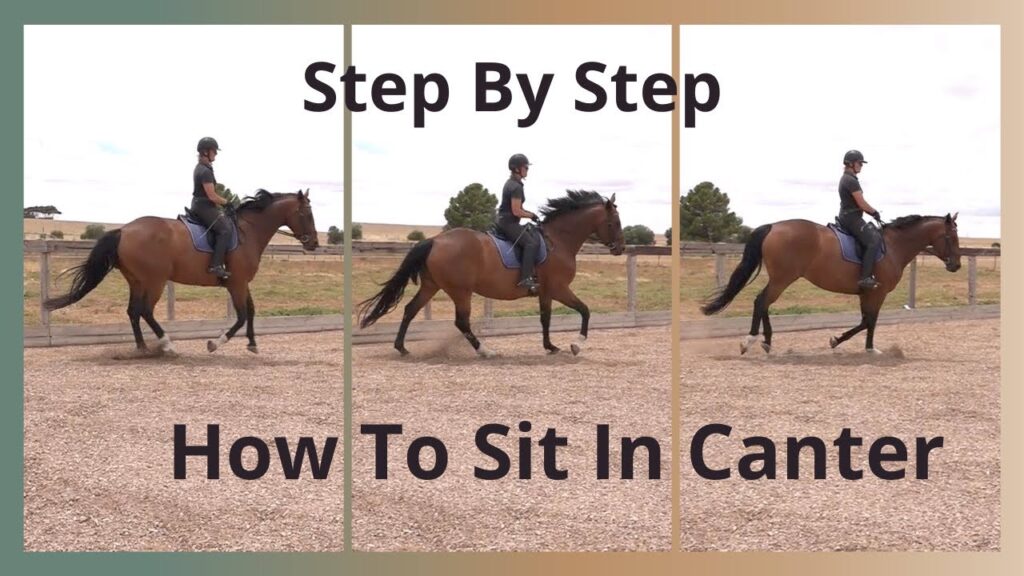
Developing a Personalized Training Plan
Developing a personalized training plan is essential for overcoming the fear of cantering. By setting achievable goals, creating a structured practice routine, tracking progress, and celebrating achievements, riders can stay motivated and focused on their journey.
Setting achievable goals and milestones
Setting achievable goals and milestones is important for maintaining motivation and measuring progress. Start by defining specific and realistic goals related to cantering. These goals could include cantering confidently for a certain duration, mastering specific cantering patterns, or conquering a fear-inducing obstacle. Break down these goals into smaller milestones to make the progress more manageable and rewarding.
Creating a structured practice routine
Consistency is key in overcoming fear and building confidence. Create a structured practice routine that includes dedicated time for cantering exercises. Incorporate a variety of exercises that gradually increase in difficulty and focus on different aspects of cantering, such as transitions, speed control, or riding patterns. Consistently practicing these exercises will help riders develop competence and familiarity.
Tracking progress and celebrating achievements
Keeping track of progress and celebrating achievements is crucial for maintaining motivation and boosting confidence. Keep a riding journal or use a progress tracking app to record cantering milestones, observations, and personal reflections. Take time to celebrate even the smallest achievements and milestones, acknowledging the hard work and progress made along the way.
Adapting the training plan based on individual needs
Every rider is unique, and it’s important to adapt the training plan based on individual needs. Be flexible and willing to tailor the plan to address specific fears or challenges. Modify exercises, seek additional support if necessary, and make adjustments as riders progress and overcome obstacles. A personalized training plan ensures that riders are consistently working towards their goals while addressing their specific needs.
Overcoming Fear through Exposure Therapy
Exposure therapy can be a valuable technique in overcoming the fear of cantering. By gradually exposing the rider to cantering in safe and controlled environments, utilizing virtual reality simulations, or seeking professional guidance, riders can develop resilience and confidence.
Systematic desensitization techniques
Systematic desensitization techniques involve gradually exposing riders to the fear-inducing stimulus in a controlled and progressive manner. Start by visualizing cantering experiences, watching videos or pictures of others cantering, and then progress to simulated or controlled cantering exercises. Over time, riders can build resilience and reduce fear through repeated exposure.
Virtual reality simulations for fear desensitization
Virtual reality simulations provide an immersive and controlled environment for fear desensitization. Virtual reality programs specifically designed for horseback riding can help riders experience cantering in a safe and controlled manner. By repeatedly engaging in simulated cantering exercises, riders can build confidence and reduce fear in a virtual setting before transitioning to real-world cantering experiences.
Gradual exposure to cantering in safe environments
Gradual exposure to cantering in safe environments is crucial for desensitization. Start by slowly reintroducing cantering exercises in familiar and controlled settings, such as a riding arena or round pen. Focus on building comfort and confidence through incremental progress, acknowledging and addressing any fears or anxieties that may arise.
Professional guidance and supervision throughout
Seeking professional guidance and supervision throughout the exposure therapy process is essential. A qualified instructor, trainer, or therapist can provide support and ensure that exposure exercises are conducted safely and effectively. They can offer guidance in setting appropriate challenges, adjusting the pace of exposure, and providing reassurance and feedback throughout the process.
Supporting Mental and Emotional Well-being
Supporting mental and emotional well-being is crucial in overcoming fear and enjoying the thrill of cantering. By practicing self-care, managing stress and anxiety, and seeking professional help if needed, riders can cultivate a positive and empowering mindset.
Practicing self-care and relaxation techniques
Self-care plays a vital role in maintaining mental and emotional well-being. Incorporate activities that promote relaxation, such as gentle yoga, meditation, or engaging in hobbies outside of horseback riding. Taking time for oneself and prioritizing self-care can alleviate stress, anxiety, and promote a positive mindset.
Managing stress and anxiety-related to horseback riding
Horseback riding can be both physically and mentally demanding, and it is essential to manage stress and anxiety related to the sport. Practice stress-management techniques, such as deep breathing exercises, mindfulness, or journaling, to cope with riding-related stressors. Developing healthy coping mechanisms can help riders navigate fear and anxiety more effectively.
Seeking professional help for underlying mental health issues
If fear and anxiety related to cantering persist or significantly interfere with daily life, it may be beneficial to seek professional help for underlying mental health issues. A mental health professional can provide an accurate diagnosis, offer specialized strategies for managing anxiety, address any trauma-related concerns, and provide ongoing support tailored to the rider’s needs.
Surrounding oneself with a supportive riding community
Building a supportive network within the riding community is essential. Surrounding oneself with like-minded individuals who understand the challenges of overcoming fear and who can provide encouragement and support can be highly motivating. Participate in riding clubs, attend workshops or retreats, and engage in online communities to connect with others on a similar journey.
Building Resilience and Accepting Challenges
Building resilience and embracing challenges are crucial elements in overcoming the fear of cantering. By embracing a growth mindset, learning from setbacks, and setting goals, riders can build resilience and thrive in their horseback riding journey.
Embracing the mindset of continuous improvement
Embrace the mindset of continuous improvement and growth. Recognize that progress is not always linear and that setbacks can provide valuable learning experiences. Cultivating a growth mindset allows riders to view challenges as opportunities for growth rather than obstacles, fostering resilience and perseverance.
Learning from setbacks and embracing challenges
Setbacks and challenges are inevitable in any learning process. Instead of being discouraged by setbacks, view them as valuable lessons and opportunities for growth. Reflect on what went wrong, identify areas for improvement, and adjust the training plan as needed. Demonstrating resilience and perseverance in the face of challenges will ultimately lead to greater confidence and mastery.
Building resilience through goal setting
Goal setting plays a critical role in building resilience. Set realistic and measurable goals that align with personal aspirations and motivations. Break these goals down into smaller, manageable steps and celebrate milestones along the way. The achievement of goals, no matter how small, reinforces a sense of accomplishment and boosts confidence.
Understanding that fear is a natural part of the journey
It’s important to acknowledge that fear is a natural part of the horseback riding journey. Fear can serve as a protective mechanism, keeping riders alert and aware of potential risks. By reframing fear as a normal emotional response and embracing it as a part of the process, riders can approach their fear with self-compassion and understanding.
Celebrating Progress and Achievements
Celebrating progress and achievements is essential in maintaining motivation and boosting confidence. Take time to acknowledge and appreciate personal milestones, no matter how small. Share success stories within the riding community, inspiring and motivating others who may be on a similar journey.
Acknowledging personal milestones and achievements
Acknowledge personal milestones and achievements along the way. Whether it’s cantering confidently for the first time, completing a challenging riding pattern, or successfully cantering in a new environment, celebrate these achievements. Recognition of personal progress reinforces confidence and motivation.
Rewarding and appreciating small steps of progress
Reward and appreciate small steps of progress. Treat yourself to something special, such as a favorite snack or a relaxing activity, when you achieve a personal goal or overcome a fear-inducing challenge. These rewards create positive associations, further reinforcing confidence and sense of accomplishment.
Sharing success stories within the riding community
Share success stories within the riding community to inspire and motivate others. By sharing one’s journey of overcoming fear, riders can connect with others who may be facing similar challenges. Contributing to a supportive and encouraging riding community fosters a sense of belonging and collective growth.
Inspiring and motivating others overcoming fear
Inspire and motivate others who are on their own journey of overcoming fear. Offer support, share words of encouragement, and provide guidance to those who may be starting their cantering journey. By sharing experiences and offering support, riders can create a positive and empowering community of riders.
Conclusion
Overcoming the fear of cantering in horseback riding is a personal journey that requires patience, determination, and support. By understanding the root causes of the fear, building trust and confidence, developing proper riding techniques, working on fear management strategies, addressing safety concerns, and seeking professional coaching and support, riders can conquer their fear and enjoy the thrill of cantering. With gradual exposure and progressive challenges, a personalized training plan, exposure therapy, and focus on mental and emotional well-being, riders can build resilience, accept challenges, and celebrate their progress and achievements. So take that first step, embrace the journey, and discover the joy and fulfillment that cantering in horseback riding can bring.
For more information on horseback riding and overcoming fear, visit our website http://horsebackridingdude.com. Join our community of passionate riders and discover a wealth of resources and support to enhance your horseback riding experience.
